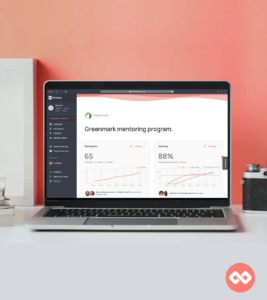Employee resource groups (also known as ERGs or affinity groups) are voluntary, identity-based communities formed by employees in a company.
ERGs can have various purposes, but most aim to give employees a safe space to connect, discuss, and raise awareness about issues facing their community—both within the company and society at large.
Some examples of ERGs include:
- Parents returning from parental leave
- BIPOC
- LGBTQIA+
- Women
- Immigrants
- Employees with disabilities
In this post, we’ll explore why ERGs are important, how your organization can support them, some possible pitfalls of these groups, and how a mentoring program can add value.
Let’s get to it.

Why are Employee Resource Groups (ERGs) Important?
According to the Society for Human Resource Management, employee resource groups are good for business. That’s because they allow organizations to ensure employees have an opportunity to be heard, valued, and engaged.
And this isn’t just in theory—it’s been proven in practice:
- AT&T has said that ERGs are the cultural lifeblood of its organisation.
- Hilton’s ERG membership jumped by 492% from 2012 to 2019, providing a more inclusive workplace and culture.
- HSBC’s ERGs support its organization’s diversity and inclusion efforts.
ERGs play a crucial role in fostering an inclusive and diverse work environment. Here are a few reasons why they are vital to your organization:
- Increase employee engagement: ERGs help create a sense of community, which leads to increased job satisfaction, motivation and commitment to the company.
- Drive innovation: A diverse workforce fosters creativity by allowing different perspectives and ideas to come together.
- Attract and retain talent: ERGs create a culture where employees feel valued and supported, which can help you attract and retain top talent.
- Improve communication: ERGs facilitate cross-department collaboration, leading to better communication and teamwork within the organization.
- Gain insight into business performance and promote growth.
Recognizing the importance of ERGs in your organization can lead to a more dynamic and effective company culture that will improve employee performance and engagement.
How Your Organisation Can Support ERGs
Now that you know why ERGs are important, how can your business support them?
First and foremost, you can start by attributing a budget to your company’s ERGs. This can be used for events, a mentoring program, and to compensate your ERG leaders and organisers.
This budget won’t break the bank, and for all the benefits ERGs provide, any investment in them will be well worth your while.
When it comes to implementing a mentoring program, for example, it can be up to 680 times cheaper than executive coaching and 373 times cheaper than in-person training sessions.
| L&D Solution | Average Cost Per Person* |
| Executive Coaching Session | $4,760 |
| In-person Training Session | $2,613 |
| Online Leadership Course | $1,085 |
| Online Learning Subscription | $23 |
| Mentorloop (monthly cost) | $7 |
Investing in ERGs is a key strategy for supporting your employees and growing your business. By offering the following support, you can empower your ERGs to achieve their goals:
- Leadership sponsorship: Secure executive sponsorship for each ERG to provide credibility, visibility, and guidance.
- Dedicated resources: Ensure that ERGs have access to funding, office space, technology, and other resources for their initiatives.
- Professional development opportunities: Offer ERG members opportunities for skill-building workshops, conferences, and networking events.
- Recognition and rewards: Acknowledge and incentivize the hard work and contributions of ERG members through company-wide recognitions, awards, and promotions.
By offering this support, your organization will foster a more inclusive and diverse company culture that benefits both employees and the business.
The Drawbacks and Challenges
Despite the numerous benefits that ERGs bring to an organisation, there are certain drawbacks and challenges you should be aware of:
- Time commitment: ERG involvement can be time-consuming for members, potentially leading to work-life balance concerns and burnout.
- Financial investment: Allocating budgets and resources to ERGs can be challenging if your organisation has limited resources.
- Resistance to change: Introducing ERGs may face resistance from some employees who may not understand their value or perceive them as exclusive cliques.
- Maintaining momentum: Sustaining interest and engagement in ERGs can be difficult, especially when members have busy schedules or competing priorities.
Being aware of these challenges will help you manage expectations and devise strategies to ensure the ongoing success of your ERGs.
One possible drawback of ERGs is groupthink. In order to avoid this, we recommend you encourage inclusion rather than exclusion.
You may also find that there’s a false sense of security that diversity issues have been solved, but remember: just because you have an ERG doesn’t mean those ideals are shared more widely throughout the organisation. Work must be done to get everyone on the same page and ensure every team member is held to the same workplace values.
Last but not least, not all members of the ERG may share the same vision of success, which may lead to divisiveness. Make sure there is open and honest communication with those both within and outside the ERG to ensure progress is being made toward shared, regularly-communicated goals.
Supporting the People Who Support Others
Employee Resource Groups (ERGs) are a crucial part of any organization’s diversity and inclusion efforts. ERGs provide a safe space for employees with shared experiences and backgrounds to come together, support one another, and advocate for change within the company. However, ERGs can only thrive with the support of the organization and its leadership.
Organizations that invest in supporting ERGs not only benefit from stronger employee connections and an inclusive work environment but also demonstrate their commitment to employees’ well-being. Here are a few ways to support ERG leaders and members:
- Recognize their contributions: Acknowledge the hard work and dedication of the ERG members by celebrating their milestones and achievements. This recognition can be in the form of company-wide announcements, awards, or even a simple thank-you note.
- Offer company-wide support: Encourage participation and involvement from employees throughout the organization, reinforcing the idea that ERGs are an integral part of the company culture. This can be done by promoting ERG events and initiatives through company-wide communication channels or by providing funding for ERG activities.
- Provide resources and tools: Equip leaders and members with the necessary resources and tools to ensure the successful operation of ERGs. This can include access to meeting spaces, technology support, and funding for events and initiatives.
- Encourage professional development: Provide ERG members with opportunities to further their careers through skill-building workshops, leadership coaching, and mentorship programs. This support can help ERG members develop new skills and advance their careers within the organization.
By offering your support to those involved in ERGs, you will establish your company as one that values its employees and their development. Not only will this help attract and retain top talent, but it will also create a more inclusive and supportive work environment for all employees.
It’s important to note that supporting ERGs is not just the responsibility of the organization’s leadership. Every employee can play a role in supporting ERGs by participating in events, volunteering their time and skills, and advocating for change within the company. Together, we can create a workplace that is truly inclusive and supportive of all employees.
Effective Ways to Encourage Employee Resource Group Participation
Employee Resource Groups (ERGs) are a great way to foster diversity and inclusivity in the workplace. However, it can be challenging to encourage employees to participate in them. Here are some additional strategies you can implement to increase participation in ERGs:
- Offer flexible meeting times: Consider scheduling meetings at different times to accommodate employees with varying schedules. This will allow more people to attend and participate in ERGs.
- Provide training opportunities: Offer training sessions on topics related to ERGs, such as leadership development, communication skills, and cultural competency. This will help employees feel more confident in their ability to contribute to ERGs and make a difference.
- Host networking events: Plan events that allow employees to connect with members of different ERGs. This will help build relationships and foster a sense of community within the organization.
- Encourage cross-functional collaboration: Encourage ERGs to work together on projects or initiatives that benefit the organization as a whole. This will help break down silos and promote teamwork.
- Recognize and reward participation: Acknowledge and celebrate employees who actively participate in ERGs. This can be done through employee recognition programs, performance reviews, or other forms of recognition.
By implementing these additional strategies, you can create a more robust and engaged ERG program. Remember, ERGs are a powerful tool for promoting diversity and inclusivity in the workplace, and it is essential to encourage participation to reap the benefits they offer.
Leveraging ERGs to Enhance Diversity and Inclusion
ERGs, or Employee Resource Groups, are a powerful tool for enhancing diversity and inclusion in the workplace. These groups are formed by employees who share a common characteristic or interest, such as race, gender, sexual orientation, or disability. ERGs provide a platform for employees to connect with others who share their experiences and perspectives, and to advocate for their needs and interests within the company.
To leverage ERGs effectively in the area of diversity and inclusion, consider the following approaches:
- Provide training and education: Offer workshops and resources to help ERG members develop leadership, collaboration, and communication skills. This can include training on how to effectively advocate for their group’s needs and how to work with other groups to achieve common goals.
- Encourage cross-group collaboration: Facilitate meetings and joint projects between different ERGs to increase intergroup understanding and foster a sense of belonging. For example, a women’s ERG could partner with a disability ERG to organize a joint event that highlights the experiences of women with disabilities in the workplace.
- Involve ERGs in decision-making: Allow ERG representatives to participate in diversity and inclusion initiatives and planning processes, giving them a platform to voice their concerns and ideas. This can help ensure that the company’s diversity and inclusion efforts are responsive to the needs of all employees.
- Hold events and campaigns: Support ERG-driven awareness events and social campaigns to increase understanding of diversity-related issues and celebrate your organisation’s diverse workforce. For example, a pride ERG could organize a social media campaign during Pride Month to highlight the experiences of LGBTQ+ employees at the company.
By leveraging ERGs in these ways, you can help create a more inclusive company culture that fosters diversity and leads to a more productive work environment. In addition to the benefits for employees, a diverse and inclusive workplace can also improve business outcomes, such as increased innovation and better decision-making.
It’s important to note that ERGs are just one piece of the puzzle when it comes to diversity and inclusion. To truly create a culture of inclusion, companies must also address systemic barriers to equity and create policies and practices that support all employees.
The Takeaway
A Diversity, Equity, and Inclusion (DEI) mentoring program can help your organisation ensure DEI efforts are at the top of your organisation’s priorities.
In addition, DEI initiatives can help your business perform better, including:
- Being 35% more likely to have financial returns above the industry mean
- Creating more opportunities for continuous engagement
Supporting ERGs with a mentoring program can be a great way to truly invest in these groups, avoid surface-level “support”, and truly have DEI in action.
Ready to learn more about how a DEI mentoring program can support your organisation’s ERGs? Book a demo today.




